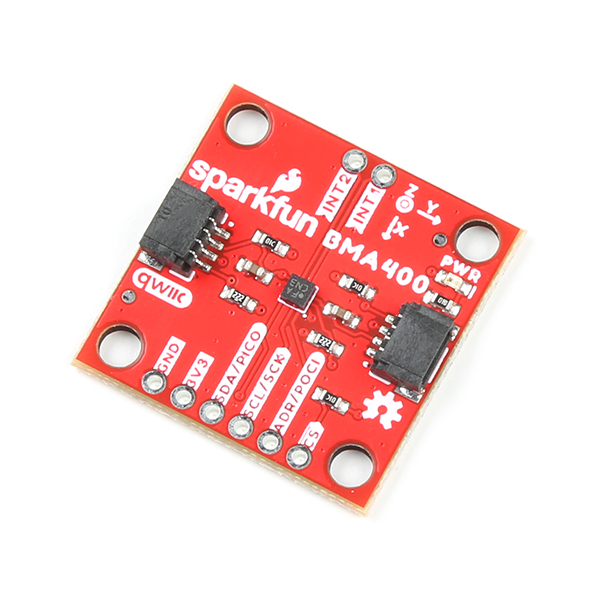SparkFun Triple Axis Accelerometer Breakout - BMA400 (Qwiic)
The SparkFun Qwiic BMA400 Triple Axis Accelerometer Breakout offers a 3-axis acceleration sensor perfect for ultra-low-power applications on an easy-to-use Qwiic breakout board. Dubbed the first "real" ultra-low power acceleration sensor, the BMA400 is perfect when used in both wearable and smart home applications. Where this sensor shines, however, is its ability to distinguish between critical situations and false signals by avoiding false alarms. The Qwiic system allows for integration into your I2C system with no soldering required. This Qwiic breakout also includes 0.1"-spaced PTH pins connected to the sensor's communication interface and interrupt pins for applications that require a traditional soldered connection.
The BMA400 from Bosch Sensortech© has a full-scale acceleration range of ±2/±4/±8/±16g with exceptionally low current consumption of < 14.5µA while operating at its highest performance settings. The sensor also includes a complete feature set for on-chip interrupts including auto wakeup/low power, step counter, activity recognition, orientation detection, and tap/double tap.
The SparkFun Qwiic Connect System is an ecosystem of I2C sensors, actuators, shields and cables that make prototyping faster and less prone to error. All Qwiic-enabled boards use a common 1mm pitch, 4-pin JST connector. This reduces the amount of required PCB space, and polarized connections mean you can’t hook it up wrong.
- Supply voltage range
- 1.72 - 3.6V
- Ultra-Low current consumption
- < 14.5µA at highest performance settings
- I2C interface (Qwiic-enabled)
- SPI interface (disabled by default)
- I2C addresses
- 0x14 (Default), 0x15
- Selectable acceleration ranges
- ±2/±4/±8/±16g
- On-chip interrupt features
- Auto-low power/auto wake-up
- Step counter
- Activity recognition (walking, running, standing still)
- Motion detection
- Orientation detection
- Tap/double tap
- Output data rate range
- 12.5 - 800Hz (Normal Mode)
- 25Hz (Low-Power Mode)
- 2x Qwiic Horizontal Connectors
SparkFun Triple Axis Accelerometer Breakout - BMA400 (Qwiic) Product Help and Resources
SparkFun Triple Axis Accelerometer Breakout - BMA400 (Qwiic) Hookup Guide
December 8, 2022
Add low power triple axis motion monitoring to your Qwiic project using the SparkFun Triple Axis Accelerometer Breakout - BMA400 (Qwiic).
SparkFun Arduino UNO R4 WiFi Qwiic Kit Hookup Guide
July 11, 2023
The SparkFun Arduino UNO R4 WiFi Qwiic Kit is a great way to get started with Arduino and the Qwiic-connect system - use this guide to get started!
Core Skill: Programming
If a board needs code or communicates somehow, you're going to need to know how to program or interface with it. The programming skill is all about communication and code.
Skill Level: Rookie - You will need a better fundamental understand of what code is, and how it works. You will be using beginner-level software and development tools like Arduino. You will be dealing directly with code, but numerous examples and libraries are available. Sensors or shields will communicate with serial or TTL.
See all skill levels
Core Skill: Electrical Prototyping
If it requires power, you need to know how much, what all the pins do, and how to hook it up. You may need to reference datasheets, schematics, and know the ins and outs of electronics.
Skill Level: Rookie - You may be required to know a bit more about the component, such as orientation, or how to hook it up, in addition to power requirements. You will need to understand polarized components.
See all skill levels
Comments
Looking for answers to technical questions?
We welcome your comments and suggestions below. However, if you are looking for solutions to technical questions please see our Technical Assistance page.
Customer Reviews
No reviews yet.




